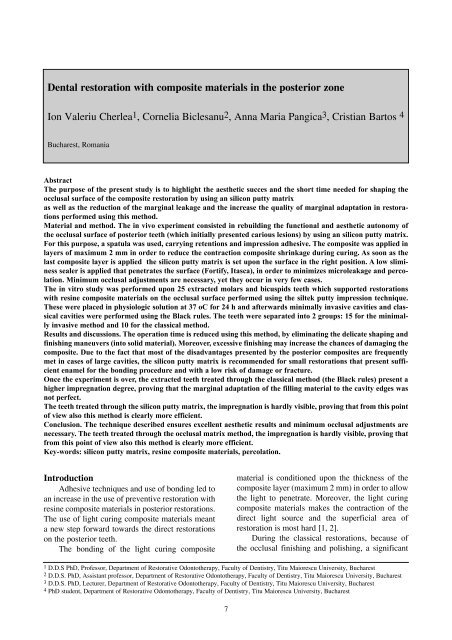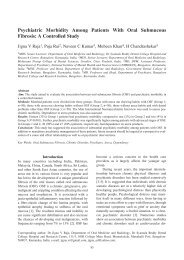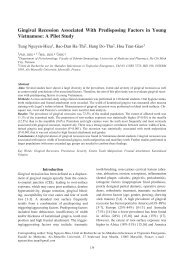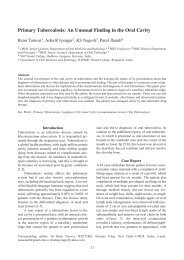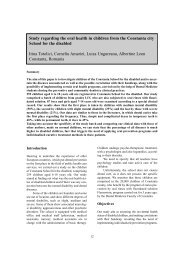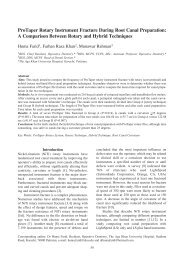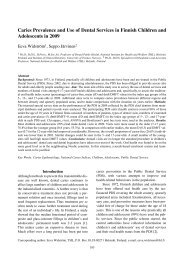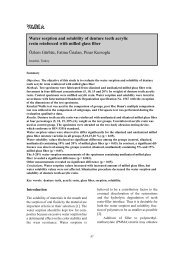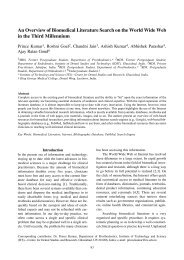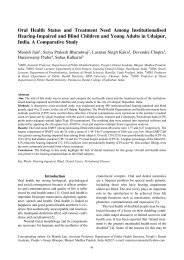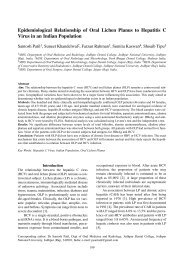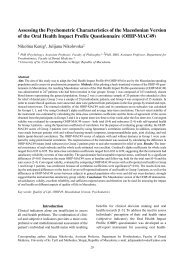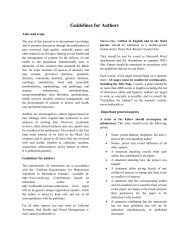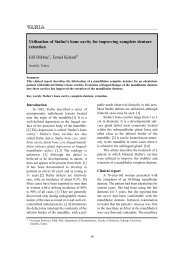Dental restoration with composite materials in the posterior zone
Dental restoration with composite materials in the posterior zone
Dental restoration with composite materials in the posterior zone
You also want an ePaper? Increase the reach of your titles
YUMPU automatically turns print PDFs into web optimized ePapers that Google loves.
<strong>Dental</strong> <strong>restoration</strong> <strong>with</strong> <strong>composite</strong> <strong>materials</strong> <strong>in</strong> <strong>the</strong> <strong>posterior</strong> <strong>zone</strong><br />
Ion Valeriu Cherlea 1 , Cornelia Biclesanu 2 , Anna Maria Pangica 3 , Cristian Bartos 4<br />
Bucharest, Romania<br />
Abstract<br />
The purpose of <strong>the</strong> present study is to highlight <strong>the</strong> aes<strong>the</strong>tic succes and <strong>the</strong> short time needed for shap<strong>in</strong>g <strong>the</strong><br />
occlusal surface of <strong>the</strong> <strong>composite</strong> <strong>restoration</strong> by us<strong>in</strong>g an silicon putty matrix<br />
as well as <strong>the</strong> reduction of <strong>the</strong> marg<strong>in</strong>al leakage and <strong>the</strong> <strong>in</strong>crease <strong>the</strong> quality of marg<strong>in</strong>al adaptation <strong>in</strong> <strong>restoration</strong>s<br />
performed us<strong>in</strong>g this method.<br />
Material and method. The <strong>in</strong> vivo experiment consisted <strong>in</strong> rebuild<strong>in</strong>g <strong>the</strong> functional and aes<strong>the</strong>tic autonomy of<br />
<strong>the</strong> occlusal surface of <strong>posterior</strong> teeth (which <strong>in</strong>itially presented carious lesions) by us<strong>in</strong>g an silicon putty matrix.<br />
For this purpose, a spatula was used, carry<strong>in</strong>g retentions and impression adhesive. The <strong>composite</strong> was applied <strong>in</strong><br />
layers of maximum 2 mm <strong>in</strong> order to reduce <strong>the</strong> contraction <strong>composite</strong> shr<strong>in</strong>kage dur<strong>in</strong>g cur<strong>in</strong>g. As soon as <strong>the</strong><br />
last <strong>composite</strong> layer is applied <strong>the</strong> silicon putty matrix is set upon <strong>the</strong> surface <strong>in</strong> <strong>the</strong> right position. A low slim<strong>in</strong>ess<br />
sealer is applied that penetrates <strong>the</strong> surface (Fortify, Itasca), <strong>in</strong> order to m<strong>in</strong>imizes microleakage and percolation.<br />
M<strong>in</strong>imum occlusal adjustments are necessary, yet <strong>the</strong>y occur <strong>in</strong> very few cases.<br />
The <strong>in</strong> vitro study was performed upon 25 extracted molars and bicuspids teeth which supported <strong>restoration</strong>s<br />
<strong>with</strong> res<strong>in</strong>e <strong>composite</strong> <strong>materials</strong> on <strong>the</strong> occlusal surface performed us<strong>in</strong>g <strong>the</strong> siltek putty impression technique.<br />
These were placed <strong>in</strong> physiologic solution at 37 oC for 24 h and afterwards m<strong>in</strong>imally <strong>in</strong>vasive cavities and classical<br />
cavities were performed us<strong>in</strong>g <strong>the</strong> Black rules. The teeth were separated <strong>in</strong>to 2 groups: 15 for <strong>the</strong> m<strong>in</strong>imally<br />
<strong>in</strong>vasive method and 10 for <strong>the</strong> classical method.<br />
Results and discussions. The operation time is reduced us<strong>in</strong>g this method, by elim<strong>in</strong>at<strong>in</strong>g <strong>the</strong> delicate shap<strong>in</strong>g and<br />
f<strong>in</strong>ish<strong>in</strong>g maneuvers (<strong>in</strong>to solid material). Moreover, excessive f<strong>in</strong>ish<strong>in</strong>g may <strong>in</strong>crease <strong>the</strong> chances of damag<strong>in</strong>g <strong>the</strong><br />
<strong>composite</strong>. Due to <strong>the</strong> fact that most of <strong>the</strong> disadvantages presented by <strong>the</strong> <strong>posterior</strong> <strong>composite</strong>s are frequently<br />
met <strong>in</strong> cases of large cavities, <strong>the</strong> silicon putty matrix is recommended for small <strong>restoration</strong>s that present sufficient<br />
enamel for <strong>the</strong> bond<strong>in</strong>g procedure and <strong>with</strong> a low risk of damage or fracture.<br />
Once <strong>the</strong> experiment is over, <strong>the</strong> extracted teeth treated through <strong>the</strong> classical method (<strong>the</strong> Black rules) present a<br />
higher impregnation degree, prov<strong>in</strong>g that <strong>the</strong> marg<strong>in</strong>al adaptation of <strong>the</strong> fill<strong>in</strong>g material to <strong>the</strong> cavity edges was<br />
not perfect.<br />
The teeth treated through <strong>the</strong> silicon putty matrix, <strong>the</strong> impregnation is hardly visible, prov<strong>in</strong>g that from this po<strong>in</strong>t<br />
of view also this method is clearly more efficient.<br />
Conclusion. The technique described ensures excellent aes<strong>the</strong>tic results and m<strong>in</strong>imum occlusal adjustments are<br />
necessary. The teeth treated through <strong>the</strong> occlusal matrix method, <strong>the</strong> impregnation is hardly visible, prov<strong>in</strong>g that<br />
from this po<strong>in</strong>t of view also this method is clearly more efficient.<br />
Key-words: silicon putty matrix, res<strong>in</strong>e <strong>composite</strong> <strong>materials</strong>, percolation.<br />
Introduction<br />
Adhesive techniques and use of bond<strong>in</strong>g led to<br />
an <strong>in</strong>crease <strong>in</strong> <strong>the</strong> use of preventive <strong>restoration</strong> <strong>with</strong><br />
res<strong>in</strong>e <strong>composite</strong> <strong>materials</strong> <strong>in</strong> <strong>posterior</strong> <strong>restoration</strong>s.<br />
The use of light cur<strong>in</strong>g <strong>composite</strong> <strong>materials</strong> meant<br />
a new step forward towards <strong>the</strong> direct <strong>restoration</strong>s<br />
on <strong>the</strong> <strong>posterior</strong> teeth.<br />
The bond<strong>in</strong>g of <strong>the</strong> light cur<strong>in</strong>g <strong>composite</strong><br />
material is conditioned upon <strong>the</strong> thickness of <strong>the</strong><br />
<strong>composite</strong> layer (maximum 2 mm) <strong>in</strong> order to allow<br />
<strong>the</strong> light to penetrate. Moreover, <strong>the</strong> light cur<strong>in</strong>g<br />
<strong>composite</strong> <strong>materials</strong> makes <strong>the</strong> contraction of <strong>the</strong><br />
direct light source and <strong>the</strong> superficial area of<br />
<strong>restoration</strong> is most hard [1, 2].<br />
Dur<strong>in</strong>g <strong>the</strong> classical <strong>restoration</strong>s, because of<br />
<strong>the</strong> occlusal f<strong>in</strong>ish<strong>in</strong>g and polish<strong>in</strong>g, a significant<br />
1 D.D.S PhD, Professor, Department of Restorative Odonto<strong>the</strong>rapy, Faculty of Dentistry, Titu Maiorescu University, Bucharest<br />
2 D.D.S. PhD, Assistant professor, Department of Restorative Odonto<strong>the</strong>rapy, Faculty of Dentistry, Titu Maiorescu University, Bucharest<br />
3 D.D.S. PhD, Lecturer, Department of Restorative Odonto<strong>the</strong>rapy, Faculty of Dentistry, Titu Maiorescu University, Bucharest<br />
4 PhD student, Department of Restorative Odonto<strong>the</strong>rapy, Faculty of Dentistry, Titu Maiorescu University, Bucharest<br />
7
OHDMBSC - Vol. VII - Supplement - June, 2008<br />
portion of best material (superficial surface) is<br />
removed through <strong>the</strong> shap<strong>in</strong>g procedure, thus<br />
reduc<strong>in</strong>g <strong>the</strong> quality of <strong>the</strong> <strong>restoration</strong> procedure.<br />
Start<strong>in</strong>g from <strong>the</strong>se issues, we considered <strong>the</strong><br />
possibility of creat<strong>in</strong>g an silicone putty matrix that<br />
would be used for better model<strong>in</strong>g <strong>the</strong> surface of<br />
<strong>the</strong> <strong>restoration</strong>, reduc<strong>in</strong>g <strong>the</strong> need for extra shap<strong>in</strong>g<br />
and thus elim<strong>in</strong>at<strong>in</strong>g <strong>the</strong> above mentioned disadvantages.<br />
Material and method<br />
“In vivo” study<br />
Follow<strong>in</strong>g a thorough cl<strong>in</strong>ical and radiological<br />
exam, <strong>the</strong> portion that needs <strong>restoration</strong> is isolated<br />
<strong>in</strong> order to prevent saliva <strong>in</strong>filtration and consequent<br />
bond<strong>in</strong>g problems. In case <strong>the</strong> occlusal surface<br />
presents deep pits and grooves, bond<strong>in</strong>g agent<br />
(res<strong>in</strong>) is applied (<strong>with</strong>out acid upon <strong>the</strong> enamel) –<br />
<strong>in</strong> order to create a more favorable occlusal anatomy<br />
(fig.1).<br />
Fig 1. Cavity diagnosis<br />
Retentions and impression adhesives are<br />
applied on a spatula (fig 2).<br />
Then, an impression polyv<strong>in</strong>ylsiloxane material<br />
is <strong>in</strong>jected (Extrude, Kerr, Romulus, MI, SUA).<br />
Express impression material produced by 3M<br />
was used to perform this study.<br />
The preparation technique described by<br />
Simonsens or Swift for preventive res<strong>in</strong> <strong>restoration</strong>s<br />
is performed next [3]. Cavity lesions are<br />
removed sacrific<strong>in</strong>g a m<strong>in</strong>imum dental structure,<br />
us<strong>in</strong>g high-speed small rounded bur such as a 329<br />
or 2 or diamond bur. No extension of <strong>the</strong> treatment<br />
<strong>in</strong> <strong>the</strong> pits or fissure <strong>in</strong> <strong>the</strong> non-cavity areas will be<br />
done and <strong>with</strong>out sharp <strong>in</strong>ternal angles [4,5].<br />
With<strong>in</strong> <strong>the</strong> deep cavities, where dent<strong>in</strong> is less<br />
than 0,5 mm thick, a th<strong>in</strong> layer of CaOH is recommended<br />
[5,6]<br />
On <strong>the</strong> rema<strong>in</strong><strong>in</strong>g dent<strong>in</strong>, a glass-ionomer<br />
cured cement layer (Vitrebond, Irv<strong>in</strong>e) is placed, <strong>in</strong><br />
order to release fluoride and to reduce percolation<br />
[1,2].<br />
Phosphoric acid 37% gel (Scothbond Etchant,<br />
3M-ESPE) is placed on enamel for 30 seconds,<br />
r<strong>in</strong>se for 20 seconds, and dry <strong>with</strong> uncontam<strong>in</strong>ated<br />
air <strong>with</strong> oil drops. A bond<strong>in</strong>g agent can be now<br />
placed on <strong>the</strong> rema<strong>in</strong>ed dent<strong>in</strong>.<br />
O<strong>the</strong>rwise, a bond<strong>in</strong>g agent (ProBond, L.D.<br />
Caulk) is applied and will be cured for 20 seconds.<br />
ProBond bond<strong>in</strong>g agent streng<strong>the</strong>ns rema<strong>in</strong><strong>in</strong>g<br />
tooth structure while elim<strong>in</strong>at<strong>in</strong>g postoperative sensitivity.<br />
The choice of <strong>composite</strong> <strong>in</strong> <strong>the</strong> <strong>posterior</strong> area is<br />
made upon <strong>the</strong> cl<strong>in</strong>ical performances.<br />
For this study an cured nano-filled <strong>composite</strong><br />
(Filtek Supreme, 3M-ESPE) was used because it<br />
has high wear resistance, it is radioopaque and filters<br />
<strong>the</strong> fluoride [7, 8]<br />
The <strong>composite</strong> is applied <strong>in</strong> layers - no more<br />
than 2 mm - <strong>in</strong> order to reduce <strong>the</strong> bond<strong>in</strong>g contraction<br />
and <strong>the</strong> consequent marg<strong>in</strong>al gaps.<br />
Each layer is cured for 40 seconds. For polymerization,<br />
a conventional quartz tungsten halogen<br />
light-cur<strong>in</strong>g unit (XL 2500, 3M ESPE, USA) calibrated<br />
at 500 m W/ cm² was used from a distance<br />
of 0.5 mm from its outer surface.<br />
The matrix is lubricated (fig.3) <strong>with</strong> bond<strong>in</strong>g<br />
adhesive <strong>in</strong> order to prevent stick<strong>in</strong>g between <strong>the</strong><br />
<strong>composite</strong> and <strong>the</strong> impression material.<br />
Fig 2. Spatula carry<strong>in</strong>g retentions.<br />
The spatula is placed gently upon <strong>the</strong> occlusal<br />
surface, <strong>in</strong> <strong>the</strong> area that needs <strong>restoration</strong>, until <strong>the</strong><br />
material bonds. All rema<strong>in</strong><strong>in</strong>g from <strong>the</strong> impression<br />
are removed. The matrix is placed aga<strong>in</strong> to make<br />
sure it resents <strong>the</strong> necessary degree of stability.<br />
Fig 3. The impression lubricated <strong>with</strong> a th<strong>in</strong><br />
bond<strong>in</strong>g layer <strong>in</strong> order to prevent stick<strong>in</strong>g between<br />
<strong>the</strong> <strong>composite</strong> and <strong>the</strong> impression material<br />
8
OHDMBSC - Vol. VII - Supplement - June, 2008<br />
Once <strong>the</strong> last layer of <strong>composite</strong> is applied, <strong>the</strong><br />
silicon putty matrix is placed on top of <strong>the</strong> surface<br />
<strong>in</strong> <strong>the</strong> right position and <strong>the</strong> excess of <strong>composite</strong> are<br />
removed.<br />
This procedure is reiterated until all excess is<br />
removed and <strong>composite</strong> is cured for 20 seconds.<br />
Restoration image is shown <strong>in</strong> fig. 4, 5.<br />
Fig 4. The light cured of <strong>the</strong> <strong>composite</strong> <strong>restoration</strong><br />
us<strong>in</strong>g <strong>the</strong> silicon putty matrix<br />
Fig. 5. F<strong>in</strong>al image<br />
A face-penetrat<strong>in</strong>g sealant (Fortify, Bisco) is<br />
used, <strong>in</strong> order to reduce marg<strong>in</strong>al leakage and percolation.<br />
M<strong>in</strong>imum occlusal adjustments are still necessary,<br />
yet <strong>the</strong>y are needed <strong>in</strong> very few cases.<br />
In order to ensure <strong>the</strong> better results of <strong>the</strong> marg<strong>in</strong>al<br />
adaptation s<strong>in</strong>ce of percolation we performed<br />
study <strong>in</strong> vitro on <strong>the</strong> extracted teeth.<br />
The study “<strong>in</strong> vitro” was performed upon 25<br />
extracted molars and premolars supported <strong>restoration</strong>s<br />
<strong>with</strong> <strong>composite</strong> <strong>materials</strong> on <strong>the</strong> occlusal surface<br />
performed us<strong>in</strong>g silicone putty matrix. These<br />
were placed <strong>in</strong> physiologic solution at 37°C for 24<br />
h and afterwards standardized saucer shaped cavities<br />
were prepared <strong>in</strong> each teeth (2.0 mm depth and<br />
1.5 mm diameter) us<strong>in</strong>g m<strong>in</strong>imally <strong>in</strong>vasive and<br />
classical techniques (<strong>the</strong> Black rules). The teeth<br />
were separated <strong>in</strong>to 2 groups: 15 for <strong>the</strong> m<strong>in</strong>imally<br />
<strong>in</strong>vasive method and 10 for <strong>the</strong> classical method.<br />
Five types of restorative <strong>materials</strong> were used,<br />
each material be<strong>in</strong>g used on a certa<strong>in</strong> number of<br />
teeth, as displayed by <strong>the</strong> table below (table 1):<br />
Table 1. Materials and techniques used<br />
Material Occlusal Classical<br />
model<strong>in</strong>g method<br />
method (Black rules)<br />
Amelogen® Plus 5 2<br />
Ultradent Inc.<br />
Adhesive sistem<br />
(S<strong>in</strong>gle Bond)<br />
Po<strong>in</strong>t 4 - Kerr 5 2<br />
Adhesive sistem<br />
(S<strong>in</strong>gle Bond)<br />
AeliteTM LS 5 2<br />
Posterior (Bisco)<br />
Adhesive sistem<br />
(S<strong>in</strong>gle Bond)<br />
Amalgam - 2<br />
Ketac Molar - 2<br />
Easymix (3M ESPE)<br />
Fortify seal<strong>in</strong>g 2<br />
(BISCO)<br />
For model<strong>in</strong>g <strong>the</strong> teeth, we took <strong>the</strong> teeth<br />
impression before prepar<strong>in</strong>g <strong>the</strong> cavity. We used<br />
Express material, produced by 3M, and <strong>the</strong> technique<br />
used is <strong>the</strong> one previously described.<br />
Once <strong>the</strong> teeth were prepared, accord<strong>in</strong>g <strong>with</strong><br />
<strong>the</strong> procedures described above, <strong>the</strong>y were isolated<br />
<strong>in</strong> order to avoid lateral impregnation and<br />
immersed <strong>in</strong>to methyl blue 1% for one hour (fig. 6).<br />
Fig. 6. Immers<strong>in</strong>g teeth <strong>in</strong>to methyl blue 1%<br />
Five teeth were treated <strong>with</strong> us<strong>in</strong>g <strong>the</strong> Amelogen®<br />
Plus occlusal modulation technique <strong>with</strong> <strong>the</strong> matrix<br />
and 2 teeth were treated us<strong>in</strong>g <strong>the</strong> classic method.<br />
9
OHDMBSC - Vol. VII - Supplement - June, 2008<br />
Restorations made <strong>with</strong> Po<strong>in</strong>t 4 – Kerr that used<br />
<strong>the</strong> occlusal modulation technique were f<strong>in</strong>ished by<br />
apply<strong>in</strong>g Fortify seal<strong>in</strong>g (BISCO) an unfilled res<strong>in</strong>,<br />
specially formulated to seal <strong>composite</strong> surfaces, agent<br />
which reduces marg<strong>in</strong>al leakage and percolation.<br />
Teeth treated <strong>with</strong> Aelite TM LS Posterior<br />
(Bisco) (Light-Cured Low Shr<strong>in</strong>kage Hybrid<br />
Composite) us<strong>in</strong>g <strong>the</strong> occlusal modulation technique<br />
<strong>with</strong> occlusal matrix 3 were also treated <strong>with</strong> Fortify<br />
seal<strong>in</strong>g agent, but 2 were not. The teeth treated us<strong>in</strong>g<br />
<strong>the</strong> classical method and restored <strong>with</strong> Aelite TM LS<br />
Posterior Bisco were not sealed (fig. 7, 8, 9, 10).<br />
Fig.10. F<strong>in</strong>al <strong>restoration</strong><br />
Classical treatment of <strong>the</strong> cavities <strong>in</strong>cluded<br />
amalgam (fig.11, 12) and Ketac Molar Easymix<br />
(3M ESPE) <strong>restoration</strong>s.<br />
Fig.7. Initial aspect of dental caries<br />
Fig 11. Cavity for <strong>the</strong> tooth treated <strong>with</strong> amalgam<br />
Fig 8. Occlusal matrix for <strong>the</strong> tooth treated <strong>with</strong><br />
AeliteTM LS Posterior Bisco<br />
Fig 12. Amalgam obturation before polish<strong>in</strong>g<br />
Fig 9. Cavity surface<br />
After teeth were treated, <strong>the</strong>y were sectioned<br />
us<strong>in</strong>g a diamond disc <strong>in</strong> order to observe <strong>the</strong><br />
impregnation degree of each method.<br />
The follow<strong>in</strong>g images present some of <strong>the</strong><br />
most representatives sections (fig.13, 14, 15).<br />
10
OHDMBSC - Vol. VII - Supplement - June, 2008<br />
Fig 13. Section <strong>with</strong><strong>in</strong> <strong>the</strong> tooth treated <strong>with</strong> amalgam<br />
us<strong>in</strong>g <strong>the</strong> classical method.<br />
Fig 14. Section <strong>with</strong><strong>in</strong> <strong>the</strong> tooth treated <strong>with</strong><br />
Aelite TM LS Posterior (Bisco) us<strong>in</strong>g <strong>the</strong> occlusal<br />
matrix technique and <strong>the</strong> Fortify seal<strong>in</strong>g agent<br />
that reduces marg<strong>in</strong>al leakage and percolation.<br />
Fig 15. Section <strong>with</strong><strong>in</strong> <strong>the</strong> tooth treated <strong>with</strong><br />
Aelite TM LS Posterior (Bisco) us<strong>in</strong>g <strong>the</strong> classical<br />
method. Fortify seal<strong>in</strong>g agent was not used.<br />
Discussions<br />
The occlusal matrix method is very useful for<br />
accurately model<strong>in</strong>g <strong>the</strong> <strong>restoration</strong> surface thus<br />
reduc<strong>in</strong>g <strong>the</strong> need for shap<strong>in</strong>g <strong>the</strong> surface and elim<strong>in</strong>at<strong>in</strong>g<br />
<strong>the</strong> subsequent disadvantages.<br />
There are many advantages deriv<strong>in</strong>g from<br />
us<strong>in</strong>g <strong>the</strong> occlusal matrix technique <strong>in</strong> order to<br />
rebuild <strong>the</strong> functional and aes<strong>the</strong>tic autonomy of<br />
<strong>the</strong> <strong>posterior</strong> teeth (that presented <strong>in</strong>itially carious<br />
lesions).<br />
The operation time is reduced us<strong>in</strong>g this<br />
method, by elim<strong>in</strong>at<strong>in</strong>g <strong>the</strong> delicate shap<strong>in</strong>g and<br />
f<strong>in</strong>ish<strong>in</strong>g maneuvers (<strong>in</strong>to solid material).<br />
Moreover, excessive polish<strong>in</strong>g may <strong>in</strong>crease <strong>the</strong><br />
risk of damag<strong>in</strong>g <strong>the</strong> <strong>composite</strong>.<br />
Use of <strong>composite</strong> res<strong>in</strong>s allows conserv<strong>in</strong>g <strong>the</strong><br />
dental structure by means of narrow and superficial<br />
preparations and it is not dependent upon <strong>the</strong> thickness<br />
of <strong>the</strong> material (for resiliency purposes) - as it<br />
is <strong>in</strong> <strong>the</strong> case of amalgam.<br />
Conserv<strong>in</strong>g <strong>the</strong> dental structure <strong>in</strong>creases <strong>the</strong><br />
life of <strong>the</strong> <strong>restoration</strong>.<br />
A larger cavities preparation has proven to significantly<br />
weaken <strong>the</strong> resiliency of <strong>the</strong> dental crown<br />
and <strong>the</strong> bond<strong>in</strong>g <strong>composite</strong>s re<strong>in</strong>force <strong>the</strong> structural<br />
<strong>in</strong>tegrity of <strong>the</strong> cusps [8].<br />
Still, <strong>the</strong> use of <strong>composite</strong> res<strong>in</strong>s has its disadvantages.<br />
The bond<strong>in</strong>g contraction may lead to<br />
postoperative sensitivity and to marg<strong>in</strong>al percolation<br />
[9]<br />
Cl<strong>in</strong>ical studies show that damage and secondary<br />
cavities are <strong>the</strong> causes for <strong>the</strong>se failures.<br />
In order to ensure <strong>the</strong> success, a selection of<br />
cases must be performed.<br />
The follow<strong>in</strong>g rules should be followed<br />
[8,9,10]<br />
1 Avoid<strong>in</strong>g bond<strong>in</strong>g <strong>in</strong> <strong>the</strong> central areas;<br />
2 The width must not exceed 1/3 of <strong>the</strong> distance<br />
between cusps;<br />
3 There should not be any signs of oclusal<br />
damage caused by teeth gr<strong>in</strong>d<strong>in</strong>g<br />
4 It should be possible that <strong>the</strong> teeth be isolated<br />
<strong>with</strong> a rubber dam.<br />
Due to <strong>the</strong> fact that most of <strong>the</strong> disadvantages<br />
presented by <strong>the</strong> <strong>posterior</strong> <strong>composite</strong>s are frequently<br />
met <strong>in</strong> cases of large <strong>restoration</strong>, <strong>the</strong> occlusal<br />
matrix is recommended for small <strong>restoration</strong>s,<br />
placed between crowns that present sufficient<br />
enamel for <strong>the</strong> bond<strong>in</strong>g procedure and <strong>with</strong> a low<br />
risk of damage or fracture.<br />
At <strong>the</strong> end of <strong>the</strong> <strong>in</strong> vivo study, we noticed <strong>the</strong><br />
quickness, <strong>the</strong> eas<strong>in</strong>ess and <strong>the</strong> maximum of effectiveness<br />
obta<strong>in</strong>ed us<strong>in</strong>g <strong>the</strong> occlusal model<strong>in</strong>g technique.<br />
However, this technique can only be applied <strong>in</strong><br />
teeth <strong>with</strong> undamaged cusps <strong>zone</strong>.<br />
Once <strong>the</strong> experiment is over, <strong>the</strong> extracted<br />
teeth treated through <strong>the</strong> classical method (Black)<br />
11
OHDMBSC - Vol. VII - Supplement - June, 2008<br />
present a higher impregnation degree, prov<strong>in</strong>g that<br />
<strong>the</strong> marg<strong>in</strong>al adaptation was not perfect.<br />
The teeth treated through <strong>the</strong> occlusal matrix<br />
method, <strong>the</strong> impregnation is hardly visible, prov<strong>in</strong>g<br />
that from this po<strong>in</strong>t of view also this method is<br />
clearly more efficient.<br />
In <strong>composite</strong> <strong>restoration</strong> Fortify seal<strong>in</strong>g agent,<br />
far better results were obta<strong>in</strong>ed through both <strong>the</strong><br />
classical and <strong>the</strong> silicone matrix method. The use of<br />
<strong>composite</strong> res<strong>in</strong>s allows preservation of <strong>the</strong> dental<br />
structure, through narrow and superficial preparations<br />
and is not dependent upon <strong>the</strong> thickness of <strong>the</strong><br />
material for resiliency as it is <strong>in</strong> <strong>the</strong> case of <strong>the</strong><br />
amalgam.<br />
Preserv<strong>in</strong>g <strong>the</strong> dental structure <strong>in</strong>sures higher<br />
life.<br />
A larger occlusal cavities has proven to weaken<br />
<strong>the</strong> crown resiliency and <strong>the</strong> bond<strong>in</strong>g <strong>composite</strong>s<br />
re<strong>in</strong>force <strong>the</strong> structural <strong>in</strong>tegrity of <strong>the</strong> adjacent<br />
cusps.<br />
Conclusions<br />
Higher patient demands concern<strong>in</strong>g aes<strong>the</strong>tics<br />
led to a more frequent use of <strong>composite</strong>s on <strong>posterior</strong><br />
teeth. The technique described ensures excellent<br />
aes<strong>the</strong>tic results. The use of <strong>the</strong> silicone putty<br />
matrix facilitates <strong>the</strong> polish<strong>in</strong>g and f<strong>in</strong>ish<strong>in</strong>g procedures.<br />
Even though <strong>the</strong>se <strong>restoration</strong>s are more difficult<br />
from <strong>the</strong> procedural viewpo<strong>in</strong>t, <strong>the</strong>y allow a<br />
more conservative approach and a lower damage to<br />
<strong>the</strong> dental crown.<br />
References<br />
1. Mount G.J, Ngo H., M<strong>in</strong>imal <strong>in</strong>tervention: a new<br />
concept for operative dentistry. Qu<strong>in</strong>tessence Int 2000;<br />
31(8):527–33.<br />
2. Mount G.J., M<strong>in</strong>imal Intervention Dentistry: Rationale<br />
of Cavity Design, Operative Dentistry, 2003, 28: 92-99.<br />
3. Simonsen R.J., Preventive res<strong>in</strong> <strong>restoration</strong>s: three year<br />
results, J. Am. Dent. Assoc., 1980, 100(4):535-539.<br />
4. Tassery H, et coll., Le traitement chirurgical des<br />
lésions carieuses, Réalités Cl<strong>in</strong>iques, 2000; 11(1): 85–102.<br />
5. W<strong>in</strong>dley W.M, et coll., The effect of short-term calcium<br />
hydroxide treatment on dent<strong>in</strong> bond strengths to <strong>composite</strong><br />
res<strong>in</strong>, Dent Traumatol 2003; 19: 79-84. Blackwell<br />
Munksgaard.<br />
6. KIDD E.A.M., Caries removal and <strong>the</strong> pulpo-dent<strong>in</strong>al<br />
complex. <strong>Dental</strong> Update, 2000; 35: 104- 110.<br />
7. Derek W. Jones, FIM, <strong>Dental</strong> Composite Bio<strong>materials</strong>,<br />
J Can Dent Assoc 1998; 64:732-4<br />
8. Posner B.T., Evaluation of microfilled <strong>composite</strong><br />
res<strong>in</strong>s, British <strong>Dental</strong> Journal 1984, 156(10): 350-350.<br />
9. Peters M.C, McLean M.E., M<strong>in</strong>imally <strong>in</strong>vasive operative<br />
care, II: contemporary techniques and <strong>materials</strong> - an<br />
overview, J Adhes Dent 2001, 3(1):17–31.<br />
10. White J.M.,Eakle W.S, Rationale and treatment<br />
approach <strong>in</strong> m<strong>in</strong>imally <strong>in</strong>vasive dentistry, J Am Dent Assoc,<br />
2000, 131( No suppl_1): 13S-19S.<br />
***<br />
Correspondence to: Dr. Cornelia Biclesanu, Department of Restorative Odonto<strong>the</strong>rapy , Faculty of<br />
Dentistry, “Titu Maiorescu” University, Gh. Petrascu Street, nr. 67A, sector 3, Cod 031593, Bucharest,<br />
Romania. E-mail: corneliabicle@yahoo.com<br />
12


